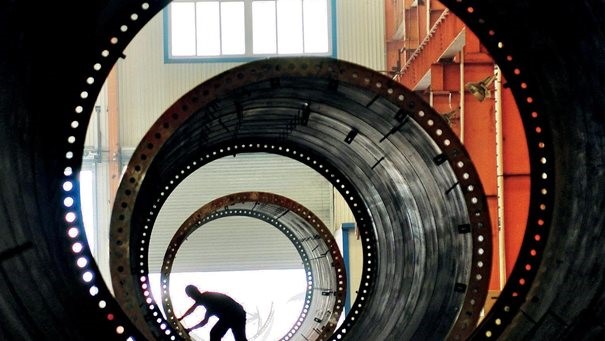Going in circles

At a recent roundtable discussion, the Clearing explored the circular economy and the changes businesses will make in terms of sustainability to compete in the future. The Clearing’s strategy director Nick Liddell examines the future of sustainable brands.
The circular economy has been a hot topic in branding and sustainability since the Ellen MacArthur Foundation was established in 2010 to accelerate the transition away from the linear ‘make-use-dispose’ economy toward a more resilient and resource-efficient way of working. The term was originally coined in 1989 by British economists to describe a business model that introduces material reuse to eliminate waste. Over the past six years, businesses like Marks & Spencer, TalkTalk, ArcelorMittal, EY, the Body Shop, River Island, Sage and BT have begun to invest in innovative circular business models and their potential to make their businesses more efficient and their brands more effective.
Despite the recent attention lavished on the circular economy, many of us are still getting to grips with its implications. For that reason, the London-based brand consultancy the Clearing, alongside Transform magazine, invited the companies listed above to participate in a roundtable. The Clearing is working to pioneer sustainable business model innovation with some of the world’s most respected brands.
For one participant, the circular economy is both a worst enemy and a best friend. It is frequently celebrated as a catalyst for disruptive innovation, but in practice it’s equally likely to be interpreted as an opportunity to ‘sex up’ recycling initiatives that already exist. Businesses in industries with recyclable materials – the lowest form of circularity – can claim to be moving towards a circular economy, without ever really having to try. And the suggestion is that many could be trying harder – particularly in moving from recycling to remanufacture and reuse. For example, the steel industry has recently described itself as the ‘permanent material in the circular economy,’ based on improving recycling rates. But why knock down a building down to melt a girder to make a girder if the original girder was robust?
There are some straightforward technical problems involved in moving towards circular economic business models, like tracking the flow of resources in a value chain and developing effective reverse logistics. But the steel example shows that there are also significant financial and legal hurdles. If a girder in a building is designed to be reused, then who should own it? How do you guarantee that it hasn’t been flawed and who will underwrite that? Who will take the hit if it breaks? These are huge issues, which is why steel reuse rates are still incredibly low. Making a business circular is about much more than just recycling materials. It’s a paradigm change in how businesses are run. Thus the circular economy causes a certain amount of internal angst in any business governed by its conscience.
One obstacle is that businesses have traditionally relied on tempting people to buy more stuff to achieve growth. But that’s not how growth works in a circular economy. Instead, it relies on persuading people to engage in more complicated behaviours like sharing their cars, renting their power drills and lending their clothes to strangers. The message becomes, ‘Buy less, but buy better. Or rent. Or share. Or make do and mend.’ This creates a fascinating but uncomfortable debate for brand owners. In theory, the circular economy is supposed to enable services to be sold alongside products, which allows businesses to top up their revenues in way that benefits both the economy and environment. The circular economy provokes businesses to reappraise the products they sell and to find better ways to deliver the same benefits. But in the real world, making the leap often requires superhuman levels of bravery and optimism.
One of the fundamental problems that champions of the circular economy face is short-termism from governments, shareholders and colleagues. Sometimes businesses need the space to develop new ideas, which won’t deliver an immediate return. That’s a huge issue. As is the ability to engage in systems thinking. People tend only consider their own part in a system. They don’t get the whole industry to look at a particular material flow to see how it works. Someone’s always grabbing and thinking about the value they can get without thinking of anybody else.
Tomorrow’s leaders won’t be the businesses that most effectively stamp on their competitors. The future belongs to those who can balance the art of competition with the art of collaboration.
In practice, the circular economy doesn’t just involve tremendous practical, technical, legal, financial and organisational challenges. There’s a more fundamental challenge that our roundtable attendees face, and it’s deeply embedded in modern corporate culture.
Charles Darwin introduced an idea of the world as a violent place where only the fittest survive. The Darwinian idea of business is as a fundamentally competitive activity – a “perennial gale of competitive destruction.” As a consequence, businesses are devoting too much time trying to get one up on the competition –- fighting to get one over each other in small areas that don’t provide a benefit to the customer. But the survival of the fittest environment only exists on the fringes. For the most part, nature is a case study in collaboration. The economy for the next 200 years will be characterised by the survival of the fittest at the fringe. Beneath that will be a massive, complex collaboration. Competition still exists, but the ability to collaborate is as vital to survival – arguably more so – than the ability to compete.
At a basic level, the vast majority of businesses are a part of a much bigger value network comprised of energy providers, manufacturers, logistics businesses, distributors, retailers, users and data aggregators. The ability to communicate, collaborate and coordinate with other businesses in the same value network is fundamental to any single organisation’s success. Beyond this, the prevailing view of business as an essentially competitive activity is holding us back from entering into potentially valuable alliances that would benefit businesses, their collaborators and their customers.
One of the most immediate benefits of a collaborative approach is that it provides a safe way to introduce new ideas and ways of working into a business. As an example, making steel is complicated. People have to be trained to think in a certain way to keep a blast furnace ticking over. The same is true of aviation: people have to think in a certain way to allow planes to take-off and land safely. The nice thing about collaboration is bringing outside thinking into the organisation. A company can’t simply tell a group of engineers to ‘think outside the box’ and expect them to follow suit. They’ve just spent twenty years training to think in the box which is why their business works in the first place. For the most part, businesses succeed because they think in the box. Inviting people from outside the business to think differently allows that to happen in a safe, controlled way.
In the case of steel manufacture, ArcelorMittal is now investing in technology where waste CO2 will be made into jet fuel. Richard Branson will be flying airplanes on their waste CO2. It’s a completely new business model in a traditional, conservative engineering business run by engineers who tend not to like change, unless there’s a timeline and costs are planned out, which you can’t do in this case because there are so many unknowns. This is where the circular economy can really add value to a business: new forms of collaboration with people you’d never expect to be working with. Virgin’s carbon problem and ArcelorMittal’s carbon problem can become an opportunity for both companies, but this means someone needs to invent a business model that gets CO2 from a waste plant in Ghent into an airplane at Heathrow airport with all the requisite safety checks in place. This is where the transformational potential of the circular economy really begins to feel real. It’s not the principle of circular economy that’s powerful, it’s the potential to collaborate and find new business models which make the difference.
Amazing things can happen as a result of collaboration; entirely new ways to unlock value emerge. The circular economy is a great way to get people asking interesting questions they wouldn’t otherwise consider. What problems do we collectively face? If we were to work with our traditional competitors, what are the resources we could share that would be beneficial? Retailers are working on the Modern Slavery Act and finding that collaboration is much more valuable than audit. Organisations working with other companies in their industries and beyond are finding more that they can work with, that can move everybody in a much better direction. And the question, ‘What have we got that we can share?’ is worth spending time on.
Tomorrow’s leaders won’t be the businesses that most effectively stamp on their competitors. The future belongs to those who can balance the art of competition with the art of collaboration.












